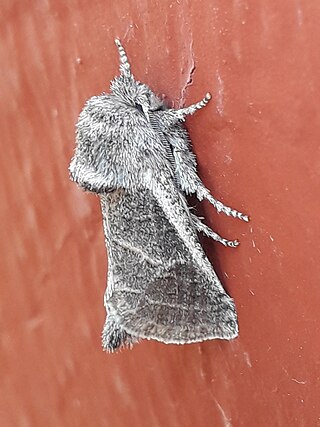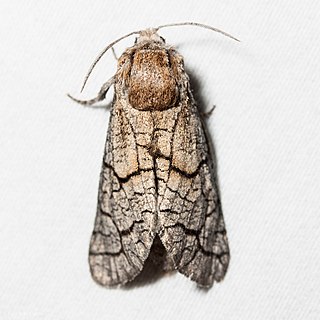
Acossus terebra is a species of moth of the family Cossidae. It is found in Eurasia, including Israel, Turkey, northern Spain, central and southern Europe, southern Sweden, Finland, the Baltic region, Ukraine, the central part of European Russia, the Caucasus, southern Siberia to southern Yakutia, the southern part of the Russian Far East, Korea, Heilongjiang, Jilin and inner Mongolia.
Deserticossus arenicola is a species of moth of the family Cossidae. It is found in Russia (Dagestan), Armenia, Azerbaijan, Georgia, Turkmenistan, Kazakhstan, Uzbekistan, Kyrgyzstan, north-western China, Iran, Afghanistan, Pakistan, Egypt (Sinai) and Jordan.
Holcocerus holosericeus is a species of moth of the family Cossidae. It is found in Kazakhstan, Mongolia, Kyrgyzstan, Uzbekistan, Tajikistan, Turkmenistan, north-western China, Afghanistan, Iran, Israel, Jordan, the United Arab Emirates, Egypt, Algeria, Tunisia, Libya and Morocco. The habitat consists of deserts.
Deserticossus pulverulentus is a species of moth of the family Cossidae. It is found in Kazakhstan, Kyrgyzstan, Uzbekistan, Turkmenistan, north-western China (Xinjiang) and Israel.

Parahypopta caestrum is a species of moth of the family Cossidae. It is found on the Iberian Peninsula and in France, Italy, Austria, the Czech Republic, Slovakia, Hungary, on the Balkan Peninsula, as well as in Jordan, Israel, Syria, Iraq, Turkey, south-western Russia and Kazakhstan.
Comadia bertholdi, the lupine borer moth, is a moth in the family Cossidae. It is found in the United States, where it has been recorded from Washington, Colorado, Wyoming, Arizona, California, Nevada and New Mexico.
Comadia intrusa is a moth in the family Cossidae first described by William Barnes and Foster Hendrickson Benjamin in 1923. It is found in North America, where it has been recorded from New Mexico, Arizona and California.

Comadia redtenbacheri is a moth in the family Cossidae. It is found in North America, where it has been recorded in Mexico and southern Texas.

Miacora perplexa is a moth in the family Cossidae. It is found in North America, where it has been recorded from Colorado and western Texas to California and Oregon. The habitat consists of montane areas.

Culama crepera is a moth in the family Cossidae. It was described by Turner in 1939. It is found in Australia, where it has been recorded from southern Western Australia, through South Australia to western-central Victoria and New South Wales.
Culama dasythrix is a moth in the family Cossidae. It was described by Alfred Jefferis Turner in 1945. It is found in Australia, where it has been recorded in southern Western Australia.

Hypopta palmata is a moth in the family Cossidae first described by William Barnes and James Halliday McDunnough in 1910. It is found in North America, where it has been recorded from western Texas, Arizona, Nevada, California and Baja California Norte. The habitat consists of deserts and desert mountains.

Givira lotta, the pine carpenterworm moth, is a moth in the family Cossidae. The species was first described by William Barnes and James Halliday McDunnough in 1910. It is found in the United States, where it has been recorded from California, Arizona, New Mexico and Colorado. The habitat consists of pine forests.
Cossodes is a monotypic moth genus in the family Cossidae. Its sole species, Cossodes lyonetii, is found in south-western Western Australia.
Deserticossus consobrinus is a moth in the family Cossidae. It was described by Püngeler in 1898. It is found in China (Xinjiang)., southern Siberia, Mongolia, Kazakhstan and Kirghizistan.
Deserticossus murinus is a moth in the family Cossidae. It is found in Kazakhstan and Kirghizistan. The habitat consists of semi-deserts and mountains at altitudes between 450 and 1,800 meters.
Cryptoholcocerus is a monotypic moth genus in the family Cossidae. Its sole species, Cryptoholcocerus mongolicus, is found in south-eastern Kazakhstan, Kirghizistan, Uzbekistan, Tajikistan, Pakistan, Afghanistan and north-western China, where it is found at elevations ranging from 400 to 3,750 meters.

Zyganisus propedia is a moth in the family Cossidae. It is found in Australia, where it has been recorded from Victoria, South Australia and southern Western Australia. The habitat consists of lowland coastal forests, dry forests and heathland.
Sympycnodes dunnorum is a species of moth of the family Cossidae. It is found in Australia, where it has been recorded from Western Australia, through South Australia to Victoria, the Australian Capital Territory, New South Wales and Queensland. The habitat consists of coastal woodland and dry forests.
Sympycnodes salterra is a species of moth of the family Cossidae. It is found in Australia, where it has been recorded from northern New South Wales, Queensland and Western Australia. The habitat consists of dry woodland.







